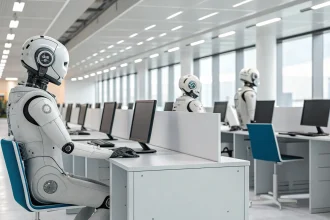Amazon and Walmart are signaling that artificial intelligence could trigger layoffs or disrupt roles, as executives across corporate America press for higher efficiency. The warnings arrive while many companies test generative AI in customer service, logistics, and back-office work. The shift has raised fresh concerns about job security, timelines for retraining, and how fast automation will reshape daily work.
Internal notes and leadership remarks suggest the message is getting more direct. Firms say AI tools are improving quickly and will change tasks across teams. That creates pressure on managers to streamline operations and on employees to upskill at speed.
“Amazon and Walmart are among firms warning employees of layoffs or disruption from AI as leaders across corporate America talk of increasing efficiency.”
Context: A New Wave Of Automation
This moment fits a long pattern. Companies have used software and robotics for decades to cut costs and raise output. Generative AI expands that push by taking on text-heavy work, from writing help-center replies to drafting code and summarizing reports.
Analysts have flagged the scope of change. A 2023 Goldman Sachs study estimated hundreds of millions of jobs globally could be exposed to automation in part due to AI. The World Economic Forum that year projected a net loss of roles in some office and customer-facing categories by 2027, even as other tech jobs grow. McKinsey research in 2023 suggested that a large share of work hours in advanced economies could be automated by 2030 under fast adoption scenarios.
For retailers and e-commerce giants, the first targets are often support, merchandising analytics, and supply chain planning. AI can route customer tickets, predict demand, and assist with inventory decisions. Those gains can reduce headcount or shift tasks to higher-value work.
What The Companies Are Signaling
The new notices emphasize both disruption and opportunity. Leaders describe AI as a tool to speed routine tasks, shrink wait times, and cut operational errors. At the same time, they warn that some jobs will change or go away. The tension is clear in the blunt phrasing now reaching staff: potential layoffs alongside promises of training.
Similar messages have surfaced across sectors since 2023. Telecom and tech firms announced restructurings tied to automation. Some banks and insurers tested generative AI for documentation and compliance. Many adopted hiring pauses in back-office roles while they assessed new tools.
Investors have encouraged this shift. Profit guidance often highlights “efficiency” targets and margin expansion. AI becomes a lever to meet those goals faster, especially in high-volume, repeatable workflows.
Worker Impact And The Skills Question
For employees, the near-term impact depends on role and location. Customer support, data entry, and scheduling face higher exposure. Product, data, and operations teams may see tasks rebalanced rather than removed. Warehouse and store jobs increasingly interact with AI-enabled systems that change daily routines.
Companies are rolling out training in prompt design, data literacy, and tool use. The key issue is timing. Reskilling takes months or years, while automation can scale in weeks once tools are proven. Labor advocates argue for clearer timelines, stronger redeployment guarantees, and pay protection during retraining.
Managers face trade-offs. Reassigning workers preserves knowledge and morale. Direct cuts reduce costs faster. The path chosen often reflects quarterly pressures and how well AI tools actually perform under real-world loads.
What Could Change Next
Early pilots suggest mixed outcomes. AI can boost output on routine tasks but may struggle with edge cases, compliance, and brand tone. Quality controls are essential. Firms that pair automation with human review often report better results than pure replacement approaches.
Regulators and courts are starting to weigh transparency, data privacy, and fairness. Several jurisdictions now require impact assessments or disclosures when AI influences hiring and staffing decisions. That could shape how and where companies deploy new systems.
- Watch for clearer job transition plans tied to AI rollouts.
- Expect more metrics on productivity gains versus headcount cuts.
- Look for training tied to specific tools, not general theory.
- Monitor rules on data use, model auditing, and worker notice.
The Bottom Line
Amazon and Walmart are signaling a harder edge to the efficiency drive. Their warnings reflect a broader shift in how large employers plan, hire, and train. AI is moving from tests to daily use in core operations, and that will reshape teams.
The next phase hinges on execution. Clear communication, measured deployment, and credible training can reduce turmoil and keep valuable experience inside the company. Absent that, anxiety will rise and turnover may follow.
Expect more companies to set targets for automation this year and to report progress in earnings calls. The key questions for workers and investors are the same: how much value AI adds, how fast it arrives, and who bears the cost of change.








